- Joined
- Dec 4, 2010
- Messages
- 519
These have no style name or made for specific uses. I create mostly hunting camping type, but in truth people seem to put them on display to look at, talk about. If they do this, why not give them something to talk about? Thus 'story knife.' One line of knife anyhow, others are for serious use, not so exciting to look upon. 'Exciting' is not what one wants in the field! "Does not follow the rules, is not normal, does not play well in sandbox with others," could describe me? I think this is just how it is, so I may as well make the most of it and laugh, see where it gets me. Not far? "Genius is the ability to make hard things look easy" I get referred to as 'OZ' who is both a man of magic, and a humbug. Magic is followed by the word 'trick' usually. It's no longer magic when you get the trick part. Been at knife making hmmm 40 years anyhow. I might have learned all I know in a year or two of proper schooling. Yes I reinvent the wheel. Why? After maybe 20 years you know a lot about wheels. Maybe. Only maybe. I grin. So. I use methods no one I know does. I can not make a pitcher of juice by adding exactly 4 cans of water. Ask my mother. "Suit to taste" is almost a motto. or "Here, watch this!" It got me where in life? Well I have minimum requirements my blades have to meet. I like the brass rod swipe test since it is so easy and fool proof. I get all test knives to a 600 grit edge, not razor, so not hard to get, it's fast. It cuts paper. I count brass rod swipes and see how far I get before blade no longer cuts paper. I can test 20 knives in a few minutes. No cost. Most factory knives ( Buck Gurber , leagtherman) go 30 to 50 swipes. Is this ok? Buyers seem happy. My minimum standard is 200 strokes and going as high as 600. Is this good? I have no idea. I can not afford anyone else's custom knife just to test it. For all I know everyone else's standard is 1,000 strokes. I never asked. I just figure if mine is almost 10 times edged retention then factory, it meets my standard. It took 5 years to get just there. I sometimes do a flex test with adapted torc wrench that holds a blade. I stopped testing and simply see if blade has any flex at all, make sure it is not brittle. I have a method after 40 years of harden and temper that I have not had a blade warp or crack in years. I use a torch and edge harden only. I communicated a little with Ed Fowler here who I admire and trusted his opinion. He at the time used a torch as well. Or knew how. My opinion is, "Why stress the entire blade when that is not necessary?" Why mess with the rest to fhe steel and risk making it worse? It is already relaxed, has carbon, all the properties I want. I save a step drawing it back. Edge harder than normal ,back softer than normal. I use quenching knife oil but set in oil back first and hesitate. I can not prove it ,but believe this drives the heat up to the edge just before full dunk. Who knows? I often now, even 'mostly' get the hardness where I like it in the hardening step. Tempering is more stress relief than altering the hardness issue. I'm trying to get better carbides so do 3 low heat tempers, in the 300 to 320 range. This give a tiny bit of color so 'something is happening' is all I know for a certainty. Going in the freezer in between. Been doing the freezer routine over 20 years now. My reasoning is, I do all sorts of odd things to the steel and do not know the effect but "I bet it stressed the metal!" I do not measure anything, so there is a good chance I messed it up compared to 'perfect' It does not hurt doing tempers to make up for messing with the steel. I test harness with files and can now tell by sound and how it drags where I am at. It took 'years' to get an even hardness along the blade. Does it really help? All I have is an opinion. I do what I call cryo treat. It's deep cold in acetone and dry ice. Is that a joke? It's much colder then the freezer and feel it has 'some effect' on 'some steels' and does no harm to any. No it is not the cold of liquid nitrogen. It's easy, I can do myself and fast. I can do 20 blades at a time (for $14) in a cooler in a parking lot where I buy the dry ice when I get to town. My finished blades meet my standards and are always improving. My latest blade can cut a 4 inch nail beating on the back with a hammer and not chips or dull. I made a video. I think then this can cut baling wire or barb wire in a survival situation. Maybe all custom knives can do this and I'm proud of nothing? I would not know. So this ends up being a tad odd. To come here and hmm not brag since I have no idea really how your knife does! I also have the idea. Any of us, can turn out a really good product in terms of how the blade for a knife holds up, in say, the $300 range. Getting the blade any better is diminishing returns for out time. The very very best will get spendy. But say 10 times as good as factory for $300 is fine. All the rest of the price of a custom knife is looks, handle material, blade fancy work ad then name on it. A $5,000 knife may cut every bit as well as a $300 one. Same steel same heat treat. Yes? No? )So being in business I would like add on value, not just the $300 cool functional blade. I want to get paid for looks. If I go off in unknown directions for looks, that would be hard to figure out, that few do, well I can grin, "No one is taking this to China to copy it and put me out of business!" I'm jumping up and down waving, all by myself. Is that cool, or is it rediculous? Lotta talk, let's see some knives here! The Wizard and the humbug presents.....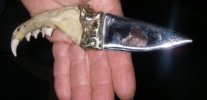
Above wolf jaw bone handle cast bronze connects for strength. Copper forged into steel. Which I am told is not possible since copper and steel melt at different temperatures.
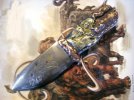
Above cast hollow bronze handle hand carved mammoth and hunters, lost wax cast from barge propeller from the Yukon River. Becomes part of the story. Acid etched 1095 steel custom cast carved copper guard from 1920's Nenana Alaska water pipes from under our school. This one skinned out a moose without resharpening when I tested it close up of the handle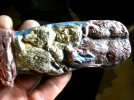
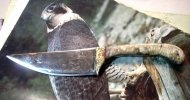
Above a chief knife musk ox horn handle cast guard and experimenting with stamping steel, used leather stamping tools

Above a knapped moss agate stone blade cast connector to a carved fossil antler
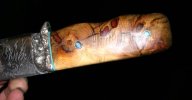 above trying opal in my pins using my own stabilzed birch wood I find, I use the cactus juice method and am happy as it ends up an entirely 'my knife 'finished product unique to me. I can show pictures where I got the wood, all part of 'the story.'Is professional done stabilizing better? I would not know. It meets my standards. Are my standards low? I've carried such knives daily, put to use in the Alaska wilds, rain, 50 below, skin bears, it holds up, I'm happy.
above trying opal in my pins using my own stabilzed birch wood I find, I use the cactus juice method and am happy as it ends up an entirely 'my knife 'finished product unique to me. I can show pictures where I got the wood, all part of 'the story.'Is professional done stabilizing better? I would not know. It meets my standards. Are my standards low? I've carried such knives daily, put to use in the Alaska wilds, rain, 50 below, skin bears, it holds up, I'm happy.
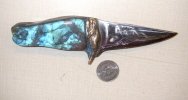 Above is a whale shape, bronze whale guard, trying labradorite stone handle. A one time idea "Cool!" Moved along with other ideas Ended up a tad heavier than I like, but great display knife. Had issues drilling pin holes in stone. One hole per diamond drill bit, geez. Is this all the pictures I'm allowed? I'll stop here. I have , like 100 knives I could show? But yes, I should go to the shop and make knives. I'm in hopes someone will get an idea! Be inspired! You do not have to have money, equipment, or paid education. All that is nice of coarse! But do not let not having these stop you! I began with no electricity in a tent! If it's not perfect, is anything or anyone? Go for it! Enjoy knife making! Show the rest of us, I for one will promise not to laugh. It's the journey that matters.
Above is a whale shape, bronze whale guard, trying labradorite stone handle. A one time idea "Cool!" Moved along with other ideas Ended up a tad heavier than I like, but great display knife. Had issues drilling pin holes in stone. One hole per diamond drill bit, geez. Is this all the pictures I'm allowed? I'll stop here. I have , like 100 knives I could show? But yes, I should go to the shop and make knives. I'm in hopes someone will get an idea! Be inspired! You do not have to have money, equipment, or paid education. All that is nice of coarse! But do not let not having these stop you! I began with no electricity in a tent! If it's not perfect, is anything or anyone? Go for it! Enjoy knife making! Show the rest of us, I for one will promise not to laugh. It's the journey that matters.

Above wolf jaw bone handle cast bronze connects for strength. Copper forged into steel. Which I am told is not possible since copper and steel melt at different temperatures.

Above cast hollow bronze handle hand carved mammoth and hunters, lost wax cast from barge propeller from the Yukon River. Becomes part of the story. Acid etched 1095 steel custom cast carved copper guard from 1920's Nenana Alaska water pipes from under our school. This one skinned out a moose without resharpening when I tested it close up of the handle


Above a chief knife musk ox horn handle cast guard and experimenting with stamping steel, used leather stamping tools

Above a knapped moss agate stone blade cast connector to a carved fossil antler
 above trying opal in my pins using my own stabilzed birch wood I find, I use the cactus juice method and am happy as it ends up an entirely 'my knife 'finished product unique to me. I can show pictures where I got the wood, all part of 'the story.'Is professional done stabilizing better? I would not know. It meets my standards. Are my standards low? I've carried such knives daily, put to use in the Alaska wilds, rain, 50 below, skin bears, it holds up, I'm happy.
above trying opal in my pins using my own stabilzed birch wood I find, I use the cactus juice method and am happy as it ends up an entirely 'my knife 'finished product unique to me. I can show pictures where I got the wood, all part of 'the story.'Is professional done stabilizing better? I would not know. It meets my standards. Are my standards low? I've carried such knives daily, put to use in the Alaska wilds, rain, 50 below, skin bears, it holds up, I'm happy. Above is a whale shape, bronze whale guard, trying labradorite stone handle. A one time idea "Cool!" Moved along with other ideas Ended up a tad heavier than I like, but great display knife. Had issues drilling pin holes in stone. One hole per diamond drill bit, geez. Is this all the pictures I'm allowed? I'll stop here. I have , like 100 knives I could show? But yes, I should go to the shop and make knives. I'm in hopes someone will get an idea! Be inspired! You do not have to have money, equipment, or paid education. All that is nice of coarse! But do not let not having these stop you! I began with no electricity in a tent! If it's not perfect, is anything or anyone? Go for it! Enjoy knife making! Show the rest of us, I for one will promise not to laugh. It's the journey that matters.
Above is a whale shape, bronze whale guard, trying labradorite stone handle. A one time idea "Cool!" Moved along with other ideas Ended up a tad heavier than I like, but great display knife. Had issues drilling pin holes in stone. One hole per diamond drill bit, geez. Is this all the pictures I'm allowed? I'll stop here. I have , like 100 knives I could show? But yes, I should go to the shop and make knives. I'm in hopes someone will get an idea! Be inspired! You do not have to have money, equipment, or paid education. All that is nice of coarse! But do not let not having these stop you! I began with no electricity in a tent! If it's not perfect, is anything or anyone? Go for it! Enjoy knife making! Show the rest of us, I for one will promise not to laugh. It's the journey that matters.